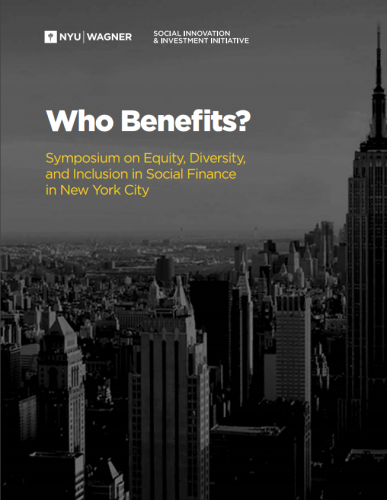The purpose of this white paper is to present the current state of equity, diversity, and inclusion (EDI) in the social finance sector in New York City, as well as to offer possible paths forward by highlighting the pioneering work of select organizations in the sector. To do this, the Social Innovation and Investment Initiative (the Initiative), housed within New York University’s Wagner School of Public Service, compiled current research as well as insights from a diverse group of industry professionals brought together on April 21, 2017 for a symposium hosted by the Initiative—Who Benefits? Symposium on Equity, Diversity, and Inclusion in Social Finance in New York City.
Download Who Benefits?
Why this topic and why now? In April of 2017, the Ford Foundation announced it was devoting up to $1 billion from its $12 billion endowment over the next ten years to mission-related investing. The foundation has made clear in its announcement that as it launches its mission-related investing, one key objective is to promote EDI within the social investment movement, paying attention to the makeup of investment teams, as well as where they invest, and with what values.
Table of Contents
Introduction
Background on the Symposium
Definitions
Why is Examining EDI in Social Finance Important?
Our Hypotheses and the New York City Context
Who Benefits?
The Symposium Survey
Key Learnings
1 Minority and Women Entrepreneurs Face Numerous Challenges Obtaining Social Finance Capital
2 Minority and Women Social Finance Investors Face Numerous Challenges Raising Capital
3 Implicit Bias has a Role in Preventing Equitable Impact Investment
4 Community Investment has a Mixed Legacy that Impacts Social Finance EDI
5 There are EDI Lessons Social Finance Can Learn from Traditional Investors
6 A Successful EDI Strategy Benefits from a Diverse and Committed Leadership Team
EDI Toolbox for Social Finance Organizations
Appendix
Citations
Source: New York University’s Wagner School of Public Service





